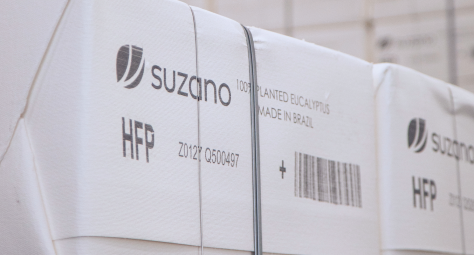sobre o que você deseja falar?


perguntas, sugestões ou problemas técnicos envolvendo a plataforma

informações sobre a empresa







Dimensão SASB
Greenhouse Gas EmissionsCódigo SASB
RR-PP-110a.1Código SASB
RT-CP-110a.1Setor SASB
Pulp & Paper ProductsSetor SASB
Containers and PackagingDimensão GRI
EnvironmentalCódigo GRI
305-1Stakeholder
PlanetTCFD
Related IndicatorsCompromissos para renovar a vida
Suzano's direct emissions (scope 1) are mainly related to the consumption of fossil fuels in stationary equipment at the industrial units and fuels used in vehicles at the forestry units.
In 2024, two new units joined the Suzano operation, Ribas do Rio Pardo in Mato Grosso do Sul, and in Suzano Packaging in the United States of America. The start-up of our Cerrado Project in Ribas and the incorporation of our first international plant led to a 5% increase in our Scope 1 emissions. It is important to note that, following the GHG Protocol, all the emissions from the North American operation in 2024 were accounted for within the Suzano group, and not just the emissions after its incorporation on October 1, and were also considered retroactively in 2022 and 2023, according to supplementary note 2.
Emissions from the stationary combustion category, which are related to generating electricity, heat, and steam and represent 72% of scope 1, increased by 6.9%. This increase is directly linked to Suzano's new units.
In the mobile category, which represents 21% of scope 1, we had an increase in emissions, mainly due to the start-up of the Ribas operation, which generates a greater demand for wood, mainly from harvesting and logistics, within our operations. In the category of agricultural emissions, which account for 7% of scope 1, waste, which account for 1%, and fugitive emissions, which account for 1%, there was a reduction in emissions due to the lower planting volume and stabilization of the forestry base.
The negative emissions from industrial processes are related to the emissions recovered in the calcium carbonate (CaCO₃) precipitation plants, or PCC, which contributed to the reduction of emissions in the scope discussed here, since in industrial processes, there is the consumption of carbon dioxide (CO₂) in the PCC. In physical-chemical processing, removals occur due to the CaCO₃ precipitation process, an input used in the industrial process, meaning that CO₂ is consumed in the PCC. The reduction in this category was due to the decrease in CO₂ exports by Suzano's factories.
Effluent emissions were not reported in 2024, as the aerobic treatment of effluents in pulp mills generates little methane emissions and is not considered by the methodology.
To find out more about managing greenhouse gas (GHG) emissions, go to “Greenhouse gas (GHG) emissions and methodology”.
The tables below contain the following information:
| 2022 | 2023 | 2024 | |
|---|---|---|---|
| tCO₂e | tCO₂e | tCO₂e | |
|
Generation of electricity, heat or steam |
1.788.872,28 |
1.700.795,49 |
1.818.904,88 |
|
Physico-chemical processing |
-46.551,54 |
-43.925,77 |
-39.118,04 |
|
Transportation of materials, products, waste and people |
535.308,38 |
512.155,10 |
521.095,86 |
|
Total |
2.277.629,11 |
2.169.024,82 |
2.300.882,71 |
| 2022 | 2023 | 2024 | ||||
|---|---|---|---|---|---|---|
| Total emissions | Percentage of representation in scope 1 | Total emissions | Percentage of representation in scope 1 | Total emissions | Percentage of representation in scope 1 | |
| tCO₂e | % | tCO₂e | % | tCO₂e | % | |
|
Stationary combustion |
1.788.872,28 |
71,75% |
1.700.795,49 |
70,38% |
1.818.904,88 |
71,79% |
|
Mobile combustion |
535.308,38 |
21,47% |
512.155,10 |
21,19% |
521.095,86 |
20,57% |
|
Agricultural |
172.295,37 |
6,91% |
198.649,68 |
8,22% |
186.770,85 |
7,37% |
|
Waste |
40.703,06 |
1,63% |
42.095,74 |
1,74% |
29.758,62 |
1,17% |
|
Effluents |
0,00 |
0,00% |
0,00 |
0,00% |
0,00 |
0,00% |
|
Runaways |
2.506,08 |
0,10% |
6.649,00 |
0,28% |
16.204,44 |
0,64% |
|
Industrial processes |
-46.551,54 |
-1,87% |
-43.925,77 |
-1,82% |
-39.118,04 |
-1,54% |
|
Total |
2.493.133,62 |
100,00% |
2.416.419,24 |
100,00% |
2.533.616,62 |
100,00% |
Following the principles for carrying out GHG inventories, measurement data and emission factors closest to the local reality were considered whenever possible. We try to avoid using assumptions and secondary data, emphasizing primary data from our operations, which allows us to have accurate and reliable monitoring of the company's decarbonization practices. The GHG emissions accounting for the Greenhouse Gas Emissions Inventory published in the Brazilian GHG Protocol Program Public Register is regularly verified/audited by an independent third party.
4. Scope 1 emissions are defined and calculated according to the methodology contained in The Greenhouse Gas Protocol: A Corporate Accounting and Reporting Standard (GHG Protocol), Revised Edition, March 2004, published by the World Resources Institute and the World Business Council on Sustainable Development (WRI/WBCSD).